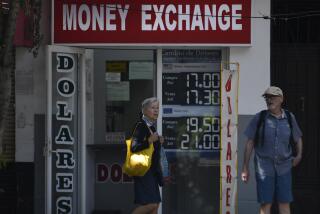Currency Crisis Pain Too Familiar
- Share via
MEXICO CITY — While Latin markets reacted with euphoria Friday to Brazil’s decision to float its currency, many Mexicans watched with trepidation, recalling the travails their economy has endured since Mexico adopted a floating currency after its own botched devaluation in December 1994.
Most analysts agree that Mexico’s 4-year-old floating exchange rate system has ultimately served the country well. The peso was allowed to float one day after the 1994 devaluation failed and the country’s foreign reserves were exhausted, leaving the Central Bank without funds to keep defending the peso’s value.
Over the last two years, Mexico has resumed strong growth, brought down inflation and rebuilt its foreign reserves since it no longer wastes them defending a fixed exchange rate.
But the cost of the devaluation and its consequences were immense--and are still being felt. As independent economist Jonathan Heath noted, “I don’t think people’s buying power will recover even in 10 years.”
The peso on Friday rose 3.8% to 10.23 per dollar, the Mexican currency’s strongest one-day gain since March 1995. But overnight interest rates, especially volatile in a floating currency system, jumped 2 percentage points to 34.5%.
And while Mexico’s stock market posted a powerful 7.8% gain Friday on the Brazil news, economist Sebastian Edwards of UCLA noted that the Mexican bourse also rose for 10 days after the 1994 devaluation. “It was only when people realized the magnitude of the crisis when the [market] started to go down,” Edwards said.
“In my view, today’s enthusiasm was probably unjustified,” he said. “The degree of euphoria was excessive. The fundamentals have not changed, because Brazil’s problem is not one of the real exchange rate being out of line but of a fiscal deficit out of control.”
Both Heath and Edwards stressed that many factors distinguish the Mexican situation in 1994, which infected economies throughout Latin America with the so-called tequila effect, from Brazil’s troubles.
In some ways Brazil is in a better position. Although it spent billions unsuccessfully trying to defend its currency, it still has more than $37.5 billion in foreign reserves, as well as access to a carefully orchestrated $41.5-billion international bailout package. On the other hand, Mexico’s budget was balanced in 1994, while Brazil has a huge 7% fiscal deficit, raising serious financing constraints.
Heath said that whereas Mexico endured months of chaos following its devaluation while it worked out a rescue program, Brazil already has a clear program and can avoid such turmoil--if it finds the political will to carry out the plan.
Edwards, a Chilean who was chief Latin American economist for the World Bank during Mexico’s crisis, said it took nearly a year, until November 1995, for the floating peso exchange rate to stabilize. In the meantime, Mexican inflation soared to 52%, interest rates leaped and thousands of borrowers defaulted, contributing to a banking crisis that still lingers.
With its exchange rate set by market supply and demand, Mexico was forced to adopt strict fiscal and monetary discipline, not to mention punishing interest rates. But exports soared with the more realistic exchange rate, and that boom in foreign trade created the base for Mexico’s deeply rooted recovery over the last two years.
Growth hit 7% in 1997 and about 4.5% last year despite worldwide uncertainty. Mexico projects 3% growth and 13% inflation this year.
More to Read
Sign up for Essential California
The most important California stories and recommendations in your inbox every morning.
You may occasionally receive promotional content from the Los Angeles Times.










